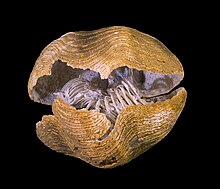Lophophore


The lophophore ( All lophophores are found in aquatic organisms.
Etymology
Lophophore is derived from the Greek lophos (crest, tuft) and -phore, -phoros (φορος) (bearing), a derivative of phérein (φέρειν) (to bear); thus crest-bearing.
Characteristics
The lophophore can most easily be described as a ring of
The lophophore surrounds the mouth and is an upstream collecting system for suspension feeding. Its tentacles are hollow, with extensions of a
Classification of lophophorates
Groups with lophophores are called lophophorates. In the old view of
Newer phylogeny place the bryozoans in the group Polyzoa, which also includes entoproctans and Cycliophora, while molluscs, brachiozoans and annelids make up their own group, with brachiozoans and annelids as possible sister taxa.[4][5]
The extinct
The position of the Hyolitha has long been disputed, but as of 2017, it has been assigned to the Lophophorata as finely-preserved specimens in the Burgess Shale can be seen to carry lophophores.[7] Lophophorates did appear paraphyletic, but that is contested.[8][9][10]
References
- ^ "lophophore". Dictionary.com Unabridged (Online). n.d.
- ^ Introduction to the Lophotrochozoa – Retrieved 3 May 2010
- PMID 18192183.
- ^ Polyzoa is back: The effect of complete gene sets on the placement of Ectoprocta and Entoprocta
- ^ Armoured worm reveals the ancestry of three major animal groups
- ^ Taylor, P.D.; Vinn, O.; Wilson, M. (2010). "Evolution of biomineralization in 'lophophorates'". Special Papers in Palaeontology. 84: 317–333. Retrieved 11 June 2014.
- S2CID 4409157.
- PMID 16556507.
- PMID 24748651.
- PMID 24238092.
